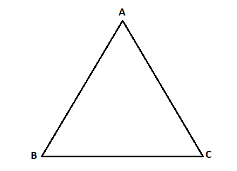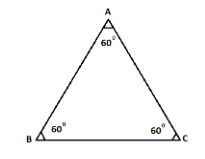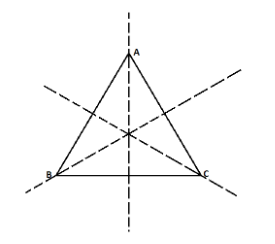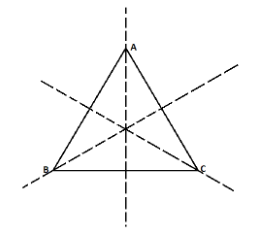
Can you draw a triangle which has exactly three lines of symmetry? Sketch a rough figure.
Answer
555k+ views
Hint: According to the question given in the question we have to draw a triangle which has exactly three lines of symmetry. So, as mentioned in the question that triangle should have exactly three lines of symmetry which is possible for an equilateral triangle so first of all we have to understand about the equilateral triangle which is explained below:
Equilateral triangle: An equilateral triangle is a triangle whose all the three sides are symmetric and equal to each other and as we know that the sum of all the interior angle of a triangle is ${180^\circ}$ and for equilateral triangle each interior angle is equal and of ${60^\circ}$
Complete step-by-step solution:
Step 1: First of all to draw a triangle which has exactly three lines of symmetry we have to draw an equilateral triangle and as we know that an equilateral triangle is a triangle whose all the three sides are symmetric and equal to each other as mentioned in the solution hint. Hence,

Step 2: Now, from the step 1 as we have drawn the triangle which has exactly three lines of symmetry which is basically a equilateral triangle and as we know that the sum of all the interior angle of a triangle is ${180^\circ}$ and for equilateral triangle each interior angle is equal and of ${60^\circ}$
As mentioned in the solution hint. Hence,

Step 3: We can also understand and draw a triangle which has exactly three lines of symmetry as below:

Final solution: Hence, we have sketched the triangle which has exactly three lines of symmetry which is as below:

Note: An equilateral triangle is a triangle whose all the three sides are symmetric and equal to each other.
The sum of all the interior angle of a triangle is ${180^\circ}$ and for equilateral triangle each interior angle is equal and of ${60^\circ}$
Equilateral triangle: An equilateral triangle is a triangle whose all the three sides are symmetric and equal to each other and as we know that the sum of all the interior angle of a triangle is ${180^\circ}$ and for equilateral triangle each interior angle is equal and of ${60^\circ}$
Complete step-by-step solution:
Step 1: First of all to draw a triangle which has exactly three lines of symmetry we have to draw an equilateral triangle and as we know that an equilateral triangle is a triangle whose all the three sides are symmetric and equal to each other as mentioned in the solution hint. Hence,

Step 2: Now, from the step 1 as we have drawn the triangle which has exactly three lines of symmetry which is basically a equilateral triangle and as we know that the sum of all the interior angle of a triangle is ${180^\circ}$ and for equilateral triangle each interior angle is equal and of ${60^\circ}$
As mentioned in the solution hint. Hence,

Step 3: We can also understand and draw a triangle which has exactly three lines of symmetry as below:

Final solution: Hence, we have sketched the triangle which has exactly three lines of symmetry which is as below:

Note: An equilateral triangle is a triangle whose all the three sides are symmetric and equal to each other.
The sum of all the interior angle of a triangle is ${180^\circ}$ and for equilateral triangle each interior angle is equal and of ${60^\circ}$
Recently Updated Pages
Master Class 9 Social Science: Engaging Questions & Answers for Success

Master Class 9 Science: Engaging Questions & Answers for Success

Master Class 9 English: Engaging Questions & Answers for Success

Master Class 9 Maths: Engaging Questions & Answers for Success

Master Class 9 General Knowledge: Engaging Questions & Answers for Success

Class 9 Question and Answer - Your Ultimate Solutions Guide

Trending doubts
Which places in India experience sunrise first and class 9 social science CBSE

Fill the blanks with the suitable prepositions 1 The class 9 english CBSE

Write the 6 fundamental rights of India and explain in detail

Difference Between Plant Cell and Animal Cell

What is pollution? How many types of pollution? Define it

What is the Full Form of ISI and RAW




